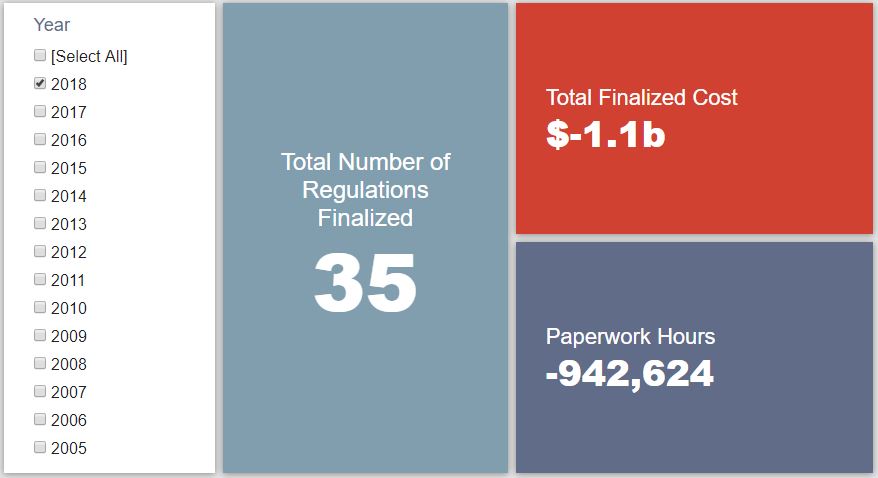Week in Regulation
February 26, 2018
Major Deregulatory Proposal Emerges (With Some Hiccups)
While most of February has seen relatively little movement towards either the cost or savings side of the regulatory ledger, this week brought a potentially major swing towards savings. Across both proposed and final rules, agencies published roughly $1.8 billion in net cost savings with 58,146 fewer paperwork burden hours. The main driver of this shift comes from a Department of Interior (DOI) proposal to significantly revise and rescind aspects of a 2016 rule on methane emissions. However, it now appears to face a unique set of legal hurdles. The per capita regulatory burden for 2018 is negative $3.27.
Regulatory Toplines
- New Proposed Rules: 33
- New Final Rules: 35
- 2018 Total Pages of Regulation: 7,972
- 2018 Final Rules: -$1.1 Billion
- 2018 Proposed Rules: -$1.3 Billion
Tracking Regulatory Modernization
In December 2017, DOI finalized a delay of a 2016 rule regarding “Waste Prevention, Production Subject to Royalties, and Resource Conservation” in order to allow for the promulgation of a substantive replacement. That replacement plan finally hit the books this week. This week’s rulemaking represents one of the more notable deregulatory proposals under this administration with roughly $2 billion in total savings, or $227 million annually. This regulatory change is far from a done deal, though.
On the same day as the proposed rule’s publication, a district court ordered an injunction against the 2017 “delay” rule. While the decision will likely face appeals, it further complicates the exact regulatory scheme on this industry and potentially the fate of this proposal. Interestingly, this area of rulemaking is hardly a stranger to such plot twists. Last May, a Congressional Review Act (CRA) resolution against the 2016 rule narrowly failed in the Senate. It was the only CRA resolution among 2017’s flurry of them that received a floor vote in each chamber yet failed to advance to President Trump’s desk. On top of these issues, this measure is still a proposed rule. Therefore, its effects are not current policy and its projected savings do not yet count towards the “regulatory budget” established under Executive Order (EO) 13,771.
Another significant deregulatory rulemaking in last week’s Federal Register was the official publication of the “Restoring Internet Freedom” order from the Federal Communications Commission. The order repeals the 2015 “Protecting and Promoting the Open Internet” order that attempted to implement “net neutrality” by classifying internet service providers as common carriers under Title II of the Communications Act. Like many other rules from independent agencies, both orders only contain qualitative discussions of costs and benefits. And regardless, EO 13,771’s budget only involves executive agencies (those under direct control of the president). Click here for further American Action Forum (AAF) analysis of net neutrality regulation.
In terms of finalized deregulatory measures applicable to EO 13,771, there was only one action of note last week. The General Services Administration published a rule what would clarify and streamline certain negotiating procedures between private entities and the federal government. However, the savings are relatively minimal at $119,000 per year.
According to AAF analysis, since the start of FY 2018 (beginning Oct. 1, 2017), executive agencies have promulgated 22 deregulatory actions with quantified cost savings against 5 regulatory measures that impose costs, under the rubric created by EO 13,771 and the administration’s subsequent guidance document on the matter. These rules combine for a net annual savings of roughly $624 million. The administration’s goal for FY 2018 is $687 million in net annual savings.
Click here to view AAF’s examination of the administration’s progress under the “one-in, two-out” executive order through the end of Fiscal Year 2017.
State of Major Obama-Era Initiatives
Based on total lifetime costs of the regulations, the Affordable Care Act has imposed costs of $53 billion in final state and private-sector burdens and 176.9 million annual paperwork hours.
Since passage, the Dodd-Frank financial reform legislation has produced more than 82.9 million final paperwork burden hours and imposed $38.9 billion in direct compliance costs.
Total Burdens
Since January 1, the federal government has published $2.4 billion in net costs savings ($1.1 billion from final rules) and new paperwork burdens amounting to 1.3 million hours (however, this includes 942,624 hours cut under final rules). Click here for the latest Reg Rodeo findings.











